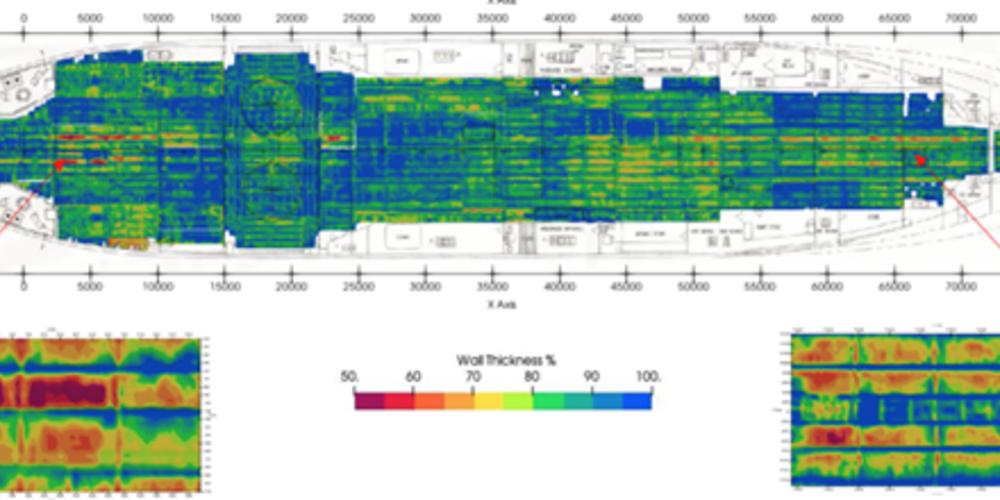Browse our services
Explore how Brookes Bell can help you
Find an expert
Meet our team, find and expert and connect
Contact us
Get in touch, we're here to help

Failure and casualty investigations are inherently a reactive specialist service to the maritime industry – one which Brookes Bell is renowned for its expertise. When something goes wrong, having the ability to understand how that happened is incredibly valuable. But it is even more impactful to proactively predict maintenance issues and potential issues down the line.
Non-Destructive Testing (NDT) offers a proactive service to prevent failures before they happen. NDT is a specialised field within The Lab, Brookes Bell’s forensic analysis and investigative service that employs a variety of complex methods to assess the condition of materials and structures without causing damage.
As explained by Arron Jackaman, Director of Non-Destructive Testing Services and Inspection Engineering at Brookes Bell, "NDT, or Non-Destructive Testing, is essential for identifying anomalies and potential defects. NDT focuses on mitigating risk and preventing failures rather than reacting to them, which is a key difference from forensic engineering."
In the maritime industry, NDT is crucial for evaluating the integrity of ship structures, pipelines, and pressurised systems, providing valuable insights that inform maintenance and repair strategies. The teams NDT surveys, performed in-service, enable process streamlining by way of results-based actions with the potential to minimise prolonged drydockings. The development of proprietary software at Brookes Bell such as ‘CMAP’ – pioneered by Arron and his team – and advanced corrosion mapping technologies, highlights Brookes Bell's commitment to leading the industry with state-of-the-art solutions.
Predictive Maintenance for Commercial Success
Since Arron joined Brookes Bell in 2016, following a career in the offshore energy sector, the standout innovation he pioneered is the CMAP service, a product developed in-house that has transformed corrosion detection and structural monitoring.
The development of CMAP was an interdisciplinary effort, bringing together naval architects, software engineers, and NDT engineers to develop a robust solution that leverages advanced technology to create digital twins of ship structures. These digital replicas provide clients with a detailed visualisation of their assets, enabling informed decision-making for maintenance and repairs.
Corrosion mapping in the maritime industry presents unique challenges compared to the oil and gas sector due to the vast scale of the vessels themselves. “They’re enormous structures. Some of the tankers and cruise ships we survey can have between 15-20 kilometres of welding that joins several square kilometres of steel plating, far exceeding what you would find in the oil and gas sector. Traditionally in the shipping industry, inspections tend to just look at a small percentage of the structure using relatively archaic conventional methods,” says Arron.
When inspecting and evaluating a ship’s welding the sheer volume necessitates a more refined and holistic approach. The application of technologies like CMAP has begun to shift this paradigm. "Taking technology that has been incredibly successful in the oil and gas industry and bringing it over to the marine sector has been a big game changer," says Arron. The digital visualisation provides a comprehensive view of a vessel's structural integrity by clearly depicting the extent of any defective welding and corrosion – an incredibly valuable insight to ship owners. The data can be used to optimise maintenance schedules and extend the life of their assets, potentially providing huge cost savings.
"It gives clients a much more informed knowledge base of how to manage their assets and plan for repairs," Arron explains. “For instance, we can predict the corrosion trends and the lifespan of a vessel, and that’s a very powerful tool from a commercial perspective. It ultimately gives ship owners the foresight and information they need to focus their maintenance periods and steel repair work. It stops them from overrunning in drydocks and having to take the vessel out of service for unplanned downtime.”
Raising Awareness of Advanced NDT Methods
Despite these advancements, raising awareness about the benefits of NDT and CMAP remains a challenge. Many ship owners are hesitant to invest in preventative maintenance technologies until a failure occurs.
Arron acknowledges this issue, stating, "A lot of stakeholders don't like to invest in a potential problem before it is actually an issue... and then two years down the line when an issue does happen, it can be incredibly expensive to fix, both in direct maintenance and drydocking costs, as well as unscheduled time out of commercial operations."
However, more and more organisations and companies are recognising the value of this technology. The Royal Navy's adoption of CMAP across their fleet of Type 23 frigates and discussions to extend its use to other vessels, underscore the software's impact in giving the insight in how to extend the operational lifespan of aging vessels.
Brookes Bell's status as the first company in the world to receive approval from Lloyd's Register for using Pulsed Eddy Current Array Technology (PECA) on ship structures is a testament to the pioneering efforts and innovation that is supporting the industry. The Lab’s NDT capabilities are not just about advanced technology; they are about delivering practical, actionable solutions that save clients time and money.